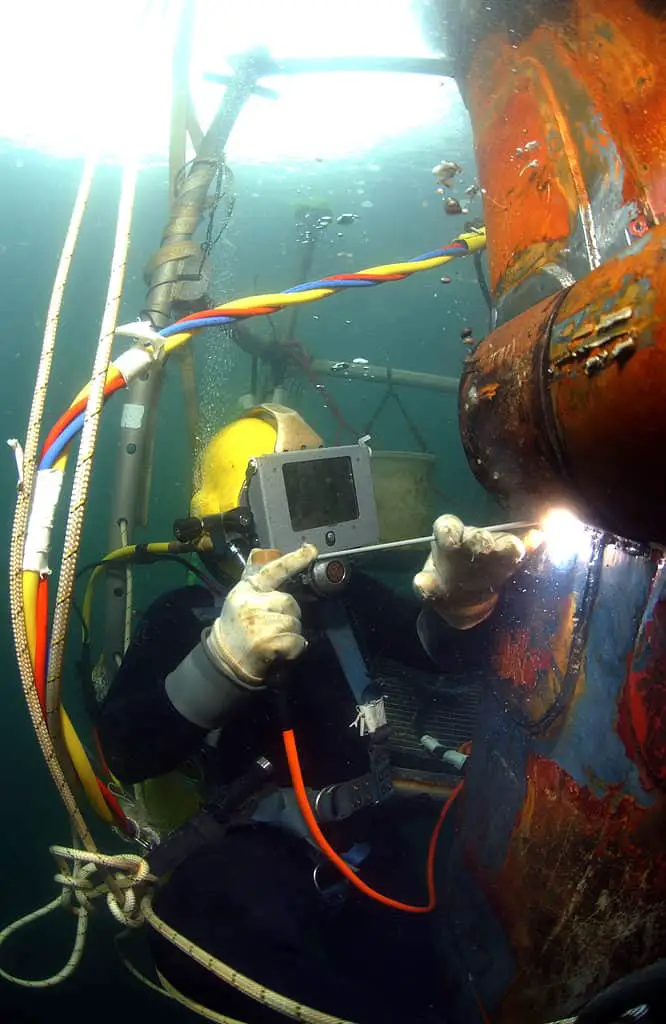Did you know that hyperbaric welding, also known as underwater welding, is among the most well-paid and sought-after jobs for commercial divers? If you’re on this page, you must be interested in becoming an underwater welder! There are a few steps to take to become one.
Hyperbaric welding has been around since its invention in 1932. Since then, this lucrative field has been operated across the globe for repairing and preserving marine infrastructures immersed partly or entirely in water.
We all know that water and electricity are a deadly duo, so the idea of underwater welding just doesn’t make sense–well, only to those who are not in the welding profession!
Hyperbaric welders are either inland welders or offshore welders. The former may work on marine vessels, bridges, and dams, while the latter work on oil rigs, pipelines, large vessels, as well as nuclear power plants.
How Hyperbaric Welding Works?
Diver-welders have different ways of performing welding tasks. These include:
Dry Welding:
Dry welding uses a hyperbaric chamber for a sound result. To get started, the area to be welded is sealed. Next, the water is drawn out through the tubes, and a gas mixture is replaced.
Once the water has been drawn out, decompression sickness must be prevented by pressurizing the hyperbaric chamber to the correct level. The welding process to be used depends on the chamber size.
There are four types of this welding technique that diver-welders may choose from:
Dry Spot Welding:
This method is used for smaller chambers. To produce dry air, the chamber is positioned on the area to be welded. As mentioned, sealing the area to be welded is necessary to prevent the water surrounding the area from coming in. Once the chamber is positioned, the diver-welder will carry out the welding process by putting the electrode in the chamber.
Dry Chamber Welding:
In this welding process, the diver-welder enters the small chamber from underneath. The small chamber only harbors the upper part of the welder’s body.
SMAW and FCAW are also typically used in dry welding.
Pressure Welding:
This method uses friction or force to fuse metals under intense pressure. Some welders refer to this welding as “solid-state.” Pressure welding may be a generic term for different welding processes, including ultrasonic welding, resistance welding, friction welding, explosion welding, and diffusion welding.
Friction welding, in particular, has become more popular as it improves the quality of the joint pieces with the use of a rotating device. This rotating device or tool creates friction necessary for welding joint sections.
Habitat Welding:
This welding process allows underwater welders to work in a small chamber. This small chamber is also referred to as the habitat. This process is used to perform hot work.
The risk of burns resulting from the flow of gases and vapors is mitigated in habitat welding as it creates an atmospheric condition for such a scenario. This makes habitat welding ideal for oil rig off-shore welding.
Other welding processes used in dry welding include:
- GMAW
- TIG Welding
- Plasma Arc Welding
Wet Welding:
The most commonly used in wet welding is Stick welding. In this process, underwater welders can create an arc with the use of a power-supplied consumable electrode
As it should be in any welding process, underwater welders should make sure that the metals to be welded are clean and free from contaminants. This ensures a safe and efficient welding process. Also, the welder should check the area prior to welding for any obstructions that may cause safety hazards.
When all systems are gone, the underwater welder may send signals to turn on the power switch. While 300-400 amp of DC can be generated by the power supply, the process where the electric arc is initiated still requires a considerably skilled welder.
The Dangers of Hyperbaric Welding:
Now, the interesting question is: How in the world do these welders not get electroshocked or electrocuted by the immense electric current generated underwater? The layer of gassy bubbles created as a result of the arc melting the flux is paramount in this case. The layer plays an important role in shielding the weld and preventing the electricity from being carried out.
However, electrocution is still a threat if the welder is not thorough and careful enough with the equipment. Improperly insulated equipment, for instance, can cause electrocution. Also, the bubbles used to protect the welder against the electric current can also cloud the area to be welded, as a result, lowers the visibility of the welder.
If the welder is not cautious, the bubbles may disrupt the weld pool. Consequently, wet welding has its own fair share of unusual challenges. For this reason, underwater welders must be exceptionally skilled. Other posing threats that underwater welders face include explosions and drowning.
The Takeaway:
Hyperbaric or underwater welding is undisputedly a dangerous profession. One slip-up may lead to anything life-threatening. Hence, only exceptionally skilled diver-welders are fit for this job.
If you are already skilled in diving with experience in welding and you’re up for a new challenge that pays handsomely, hyperbaric welding may be perfect for you.


